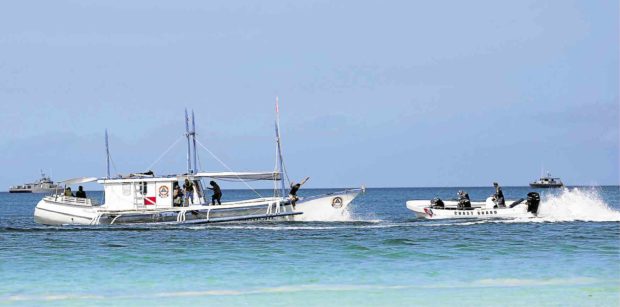
READY FOR CLOSURE Authorities practice security procedures in Boracay a day before the resort island’s closure on April 26.—LYN RILLON
ILOILO CITY — “The situation is depressing.”
The head of a social arm of the Catholic Church in the city made this statement to describe conditions of residents of Boracay following the resort island’s closure to tourists starting on April 26.
“The elderly need to buy maintenance medicines and other needs, and children need help so they can continue going to school,” said Msgr. Meliton Oso, executive director of the Jaro Archdiocese Social Action Center.
Oso, who visited the island to find out what residents needed most, said the situation was dire for many residents despite the help being given by the government.
“The assistance is not enough and not all are receiving it,” Oso told the Inquirer.
Unprepared
Tens of thousands of residents have been left without work and livelihood after President Rodrigo Duterte approved the closure of the island to tourists for a six-month rehabilitation program.
The President had called the country’s premier tourist destination as a “cesspool” because of environmental woes that ranged from structures rising on no-build zones to untreated human and other wastes being piped directly into the sea.
Oso said it was clear that the closure of the island had left many residents unprepared for six months without livelihood and sources of income.
“Their situation is depressing,” Oso said.
“Even if tuition is free for their children, they still need to spend for school supplies, transportation and allowance,” he added.
Cash all over
The Department of Social Welfare and Development (DSWD) and the Department of Labor and Employment (Dole) has spent tens of millions of pesos on aid programs in Boracay.
The DSWD has released more than P116 million in aid as of July 13, according to an agency report.
The Dole reported the release of P23 million to 2,963 workers in the informal sector as of July 5 and more than P9 million to those who had registered jobs.